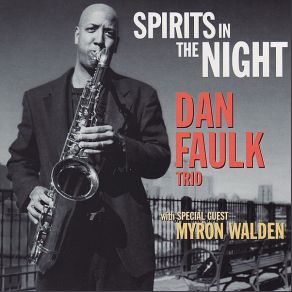Spirits In the Night
Download links and information about Spirits In the Night by Dan Faulk. This album was released in 1996 and it belongs to Jazz genres. It contains 11 tracks with total duration of 01:07:20 minutes.

|
|
|---|---|
| Artist: | Dan Faulk |
| Release date: | 1996 |
| Genre: | Jazz |
| Tracks: | 11 |
| Duration: | 01:07:20 |
| Buy it NOW at: | |
| Buy on iTunes $9.99 | |
Tracks
[Edit]| No. | Title | Length |
|---|---|---|
| 1. | The Night Has a Thousand Eyes | 6:51 |
| 2. | The Heath Blues | 7:01 |
| 3. | Angel Eyes | 6:49 |
| 4. | Stop 'n' Go | 6:01 |
| 5. | Peace Waltz | 6:57 |
| 6. | Our Love Is Here to Stay | 7:13 |
| 7. | Three Cheers for Paul Chambers | 6:55 |
| 8. | But Beatiful | 6:50 |
| 9. | Black Orpheus | 5:51 |
| 10. | Those Dirty Blues | 5:02 |
| 11. | Spirits In the Night | 1:50 |
Details
[Edit]Dan Faulk is one of the hot, young tenormen in the United States who had been quietly biding his time, playing with Barry Harris, Richard Davis, Jimmy Heath, Louis Hayes, and others before assembling his own trio. On Spirits in the Night he also employs the talents of alto saxophonist Myron Walden for a serious blowout locking of the horns. There is no doubt that Faulk is schooled in the harmonic architectures of bebop, hard bop, and post-bop and can move about the saxophone with ease. He knows all the tunes and can play them in any key. And while many of the tunes here are originals it is the covers that stand out. The reason for this is that Faulk's composing hasn't developed to the level of his other skills. His "The Heath Blues," for instance, takes a Jimmy Heath motif, plays an ostinato series of accents around it, and launches into a solo before passing the pipe to Walden, who solos, and then the theme comes back for a few more arpeggios to be stacked on top of it, and it gets carried out. When it comes to other people's tunes — such as Luiz Bonfa's "Black Orpheus," Gershwin's "Our Love Is Here to Stay," or even the Van Heusen/Burke nugget "But Beautiful" — his willingness to allow the lyric to permeate everything on the stand is truly commendable. So often performers will take the standard and move into it to prove their soloing ability around a series of changes. Here, Faulk is content with those changes, especially when in a trio setting, allowing the structure of the tune to influence the depth, tonality, and duration of his solo rather than the other way around. This isn't a perfect set, but it's very good and reveals a mature soloist trying to find his way to being a composer and a bandleader.